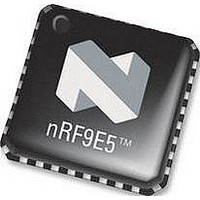NRF9E5 NORDIC SEMICONDUCTOR, NRF9E5 Datasheet - Page 70

NRF9E5
Manufacturer Part Number
NRF9E5
Description
TRX, 430-928MHZ, MCU/ADC/PWM, SMD
Manufacturer
NORDIC SEMICONDUCTOR
Datasheet
1.NRF9E5.pdf
(108 pages)
Specifications of NRF9E5
Receiving Current
12.5mA
Transmitting Current
30mA
Data Rate
50Kbps
Frequency Range
430MHz To 928MHz
Modulation Type
GFSK
Rf Ic Case Style
QFN
No. Of Pins
32
Supply Voltage Range
1.9V To
Lead Free Status / RoHS Status
Lead free / RoHS Compliant
Available stocks
Company
Part Number
Manufacturer
Quantity
Price
Company:
Part Number:
NRF9E5C
Manufacturer:
NORDIC
Quantity:
5 000
Part Number:
NRF9E5C
Manufacturer:
NORDIC
Quantity:
20 000
PRODUCT SPECIFICATION
nRF9E5 Single Chip Transceiver with Embedded Microcontroller and ADC
18.4 Instruction Timing
Instruction cycles in the nRF9E5 are four clock cycles in length, as opposed to twelve
clock cycles per instruction cycle in the standard 8051. This translates to a 3X
improvement in execution time for most instructions. However, some instructions
require a different number of instruction cycles on the nRF9E5 than they do on the
standard 8051. In the standard 8051, all instructions except for MUL and DIV take one
or two instruction cycles to complete. In the nRF9E5 architecture, instructions can take
between one and five instruction cycles to complete. For example, in the standard 8051,
the instructions MOVX A, @DPTR and MOV direct, direct each take two instruction
cycles (twenty-four clock cycles) to execute. In the nRF9E5 architecture, MOVX A,
@DPTR takes two instruction cycles (eight clock cycles) and MOV direct, direct takes
three instruction cycles (twelve clock cycles). Both instructions execute faster on the
nRF9E5 than they do on the standard 8051, but require different numbers of clock
cycles.
For timing of real-time events, use the numbers of instruction cycles from Table 55 to
Table 60 to calculate the timing of software loops. The bytes column of these table
indicates the number of memory accesses (bytes) needed to execute the instruction. In
most cases, the number of bytes is equal to the number of instruction cycles required to
complete the instruction. However, as indicated in Table 55, there are some instructions
(for example, DIV and MUL) that require a greater number of instruction cycles than
memory accesses.By default, the nRF9E5 timer/counters run at twelve clock cycles per
increment so that timer-based events have the same timing as with the standard 8051.
The timers can be configured to run at four clock cycles per increment to take advantage
of the higher speed of the nRF9E5.
18.5 Dual Data Pointers
The nRF9E5 employs dual data pointers to accelerate data memory block moves. The
standard 8051 data pointer (DPTR) is a 16-bit value used to address external data RAM
or peripherals. The nRF9E5 maintains the standard data pointer as DPTR0 at SFR
locations 0x82 and 0x83. It is not necessary to modify code to use DPTR0. The nRF9E5
adds a second data pointer (DPTR1) at SFR locations 0x84 and 0x85. The SEL bit in the
DPTR Select register, DPS (SFR 0x86), selects the active pointer. When SEL = 0,
instructions that use the DPTR will use DPL0 and DPH0. When SEL = 1, instructions
that use the DPTR will use DPL1 and DPH1. SEL is the bit 0 of SFR location 0x86. No
other bits of SFR location 0x86 are used.
currently selected data pointer. To switch the active pointer, toggle the SEL bit. The
fastest way to do so is to use the increment instruction (INC DPS). This requires only
one instruction to switch from a source address to a destination address, saving
application code from having to save source and destination addresses when doing a
block move. Using dual data pointers provides significantly increased efficiency when
moving large blocks of data.
The SFR locations related to the dual data pointers are:
Main office: Nordic Semiconductor ASA - Vestre Rosten 81, N-7075 Tiller, Norway -Phone +4772898900 - Fax +4772898989
Revision: 1.3
- 0x82 DPL0 DPTR0 low byte
- 0x83 DPH0 DPTR0 high byte
- 0x84 DPL1 DPTR1 low byte
- 0x85 DPH1 DPTR1 high byte
- 0x86 DPS
DPTR Select (LSB)
Page 70 of 108
All DPTR-related instructions use the
June 2006













